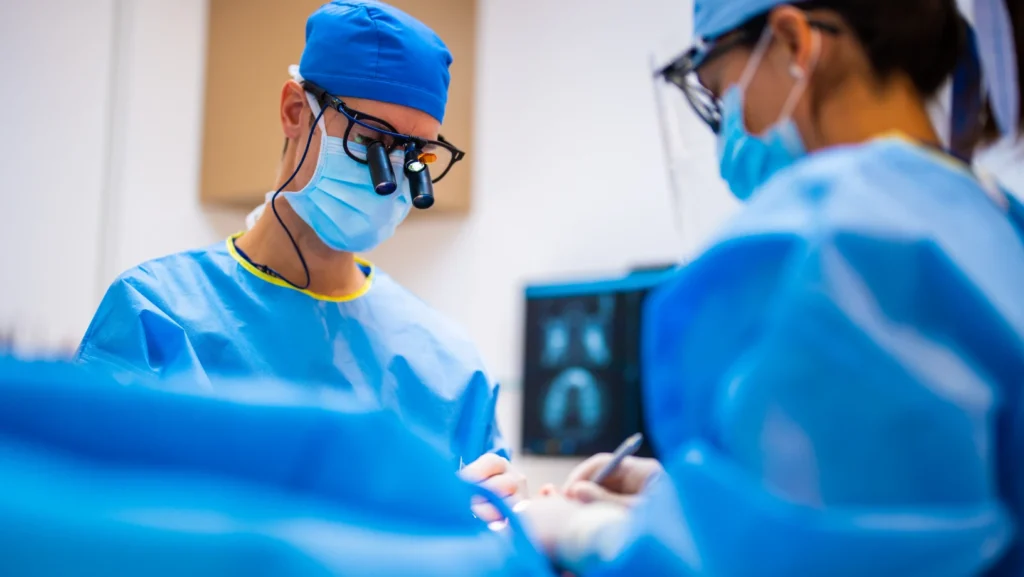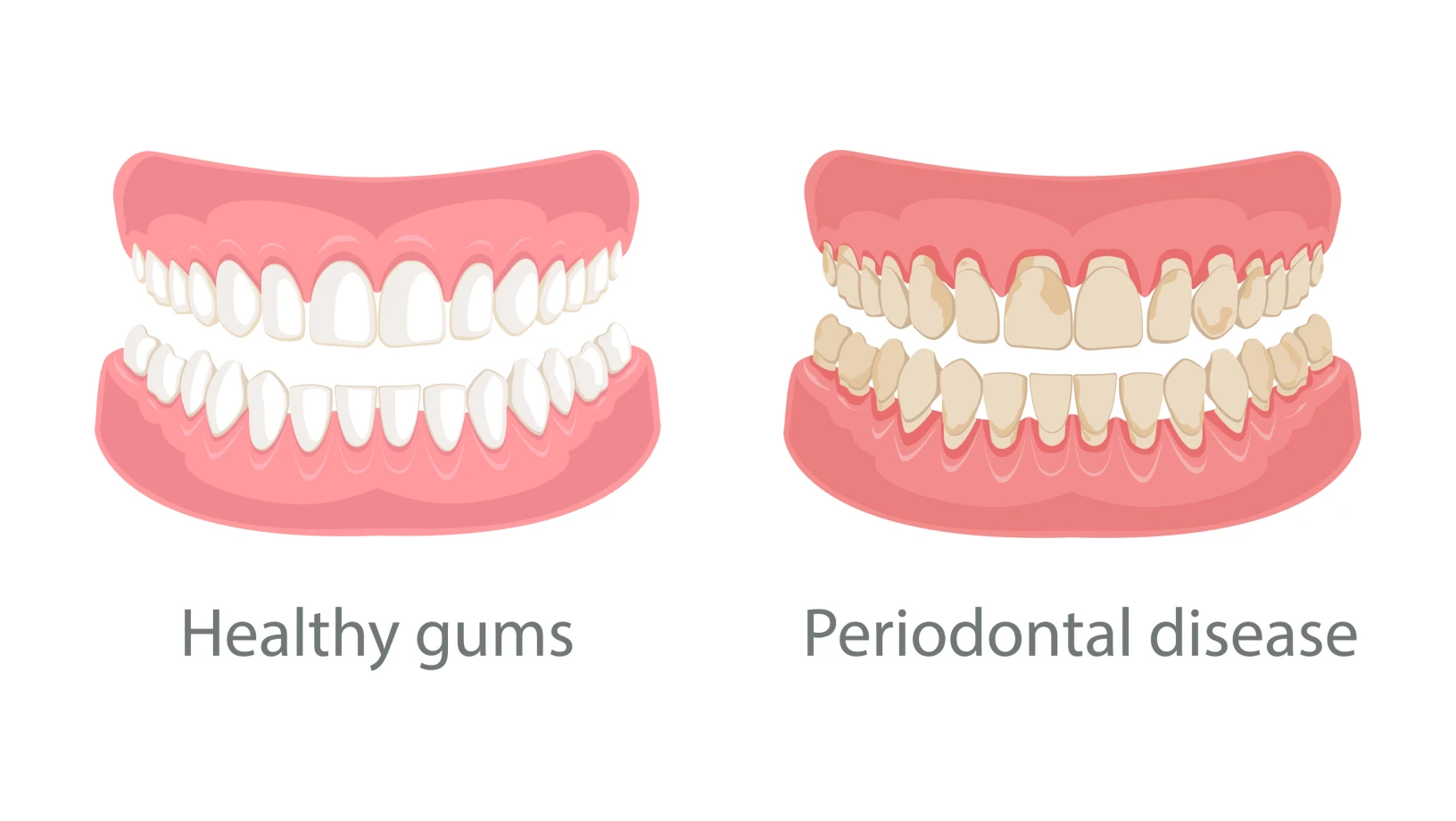Why perform a periodontal surgery?
Untreated gingivitis can advance to periodontitis.
With time, plaque (bacteria) can spread and grow below the gum line. Toxins produced by the bacteria irritate the gums and stimulate a chronic inflammatory response in which the body essentially turns on itself, and the tissues and bone that support the teeth are broken down and destroyed. Gums separate from the teeth, forming pockets between the teeth and gums that can become more infected. As the disease progresses, the pockets deepen and more gum tissue and bone are destroyed.

With time, plaque (bacteria) can spread and grow below the gum line. Toxins produced by the bacteria irritate the gums and stimulate a chronic inflammatory response in which the body essentially turns on itself, and the tissues and bone that support the teeth are broken down and destroyed. Gums separate from the teeth, forming pockets between the teeth and gums that can become more infected. As the disease progresses, the pockets deepen and more gum tissue and bone are destroyed.
Eventually, teeth can become loose and may fall out or need to be removed.
In addition, bacteria can enter the bloodstream and create complications in some medically-compromised patients or when the immune system is weak.
What are the expected benefits?
The purpose of periodontal surgery is to reduce infection and inflammation and to restore the gum and bone to the extent possible.
The surgery is intended to help keep the teeth in the operated areas and to make the oral hygiene and the maintenance more effective.
Bone regeneration of deep periodontal defects :
When indicated, regenerative materials may be implemented : the voids or defects around the teeth are filled with PRF and/or bone.
Platelet-rich fibrin (PRF)
PRF is a mixture of white blood cells, fibrin, platelets, stem cells and growth factors. There are no blood additives or chemicals. Only extracts from the patient’s own blood drawn just before the surgical procedures.
Not only does PRF speed up the healing process, it also reduces inflammation/pain and post-operative infections. This PRF can be used alone or combined with a Bone Graft material.
Bone Graft materials
Various types of graft materials may be used. These materials may include a bone obtained from a tissue bank (allografts) or your own bone.
Allografts are donated by living patients undergoing hip replacement procedures. Tissue banks screen these donors, disinfect and test the donated bone to make sure it is safe to use. Bone graft provides a framework for growth of new, living bone. Eventually, the grafted bone is entirely replaced by the patient bone.
Also learn about : Soft-tissue augmetation
Healthy teeth are surrounded by two types of tissue: gingiva and mucosa. Mucosa is like cheek tissue, it is weak and loose and does not adhere to the roots of the teeth or the underlying jawbone very well. In comparison, gingiva is a strong keratinized tissue that is firmly attached to the teeth/bone.
Mucosa is much more likely to recede, causing more root of the tooth to show, leading to tooth sensitivity and a loss of the underlying jawbone around the tooth.
Having an adequate amount of keratinized tissue is also important around implants : evidence suggests that the peri‐implant soft tissues are key to maintaining long-term peri‐implant health and aesthetics.

When do I need a soft-tissue augmentation?
- When there is an insufficient amount of attached gingiva (firm gum tissue) around teeth or implants.
- When there is a risk for the development of gum recession.
- When a recession of the gum has already taken place and teeth are sensitive to cold/heat/brushing.
- To improve the gingival appearance.
- When planning for fillings or crowns with edges at the gumline: it is important to have sufficient width of firm, adhered gingiva around the teeth or implants to withstand the irritation they may cause.
What are the expected benefits?
The purpose of gingival augmentations is to create an amount of attached gum tissue adequate to reduce the likelihood of further gum recession.
Another purpose may be to cover some of the exposed root surfaces. To enhance the appearance of the teeth and gum line, or to prevent or treat root sensitivity or root decay.
However, when a complete coverage of the exposed root surface is desired, an additional gum graft procedure can be performed or a composite restoration can be placed.
When indicated, soft tissue augmentation around implants can be performed before or at the time of implant placement, or during the implant healing phase.

Also learn about : Gum diseases
Gum Disease Symptoms
Gum disease is often silent, meaning symptoms may not appear until the advanced stages. However, warning signs of gum disease include the following:
- Red, swollen, or tender gums or other pain in your mouth;
- Bleeding while brushing, flossing, or eating hard food;
- Gums that are receding or pulling away from the teeth, causing the teeth to look longer than before;
- Loose or separating teeth;
- Persistent bad breath;
- A change in the way your teeth fit together when you bite.

Gingivitis
Gingivitis – is the mildest form of periodontal disease. It causes the gums to become red, swollen, and bleed easily. There is usually little or no discomfort at this stage. Luckily, gingivitis is reversible with professional treatment and good at-home oral care.
Periodontitis
Periodontitis – untreated gingivitis can advance to periodontitis. With time, plaque can spread and grow below the gum line. Toxins produced by the bacteria irritate the gums and stimulate a chronic inflammatory response in which the body essentially turns on itself, and the tissues and bone that support the teeth are broken down and destroyed.
Gums separate from the teeth, forming pockets between the teeth and gums that can become infected. As the disease progresses, the pockets deepen and more gum tissue and bone are destroyed. Eventually, teeth can become loose and may fall out or need to be removed.
In addition, bacteria can enter the bloodstream and create complications in some medically-compromised patients or when the immune system is weak.
Treatment of periodontitis
First-line treatment usually includes :
- Oral hygiene instructions and disease prevention;
- Deep cleaning or scaling and root- planing of the contaminated tooth root surfaces below the gums;
- Sub-gingival detox with chemical pocket irrigation;
- Local antiseptic medications;
- Reevaluation and follow-up visits.
More advanced diseases may require :
- Bacterial culturing;
- DNA testing;
- Antibiotics prescribed to take by mouth;
- Occlusal/bite adjustment;
- Biteguard;
- Corrective or regenerative surgical procedures (bone grafting procedures).
Also learn about : Prosthesis rehabilitation